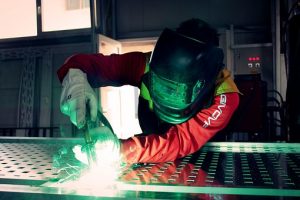
6061 is a precipitation-hardened alloy, which has magnesium and silicon as its major components. It has good mechanical properties. The alloy composition of 6061 is Silicon, iron, copper, manganese, magnesium, chromium, zinc and titanium. It is an alloy used for hot forging. It is suitable for open die forgings. It can be forged into flat and round bars, rings, blocks etc.
Steel is an alloy of iron and carbon and can be three times stronger than aluminium. It is usually used in a landing gear due to its strength and hardness as well as in the skin surface of aircraft due to high resistance.

But mostly nowadays planes are made of aluminium, a lightweight metal. The Ford tri Motor the first passenger plane was made from aluminium in 1928. Aluminium alloy 7075 has copper, magnesium and zinc for more strength but due to use of copper in aluminium makes it difficult to bend. The reason to use aluminium in aircraft is because of its lightweight and its strength. They don’t corrode readily as steel.
Forged titanium is used in airframes requiring high strengths and high toughness or when there is too little airframe space for aluminium alloys. For many years’ steels have been used in aircraft because of its high stiffness, strength, fatigue and resistance. Link here https://www.airportmetals.com.au/ offer a great quality of steels that will perfect to your aircraft.
Pure Aluminium is not suitable for the construction of aircraft because it is extremely soft. The addition of other elements makes it strong for the construction of aircraft.
Aluminium has much better conductivity than steel and is typically cheaper than steel. 6061 aluminum is softer than steel. Stainless steel can be difficult to work with but when it comes to welding steel is more likely to be weld easily than aluminium. Steel can be used at a much higher temperature as compared to aluminium. Aluminium has much better thermal conductivity than stainless steel. Steel is a very tough metal but cannot be pushed hard as aluminium because it would be cracked during the process.
The aviation industry chooses metals based on strengths, hardness, density, ductility, elasticity, Stainless steel is a common choice because it can be handled easily during processing. It is more reliable to use meaning it will not interfere in the aircraft navigation system. Its corrosion resistance makes it perfect for the aircraft to use it.
